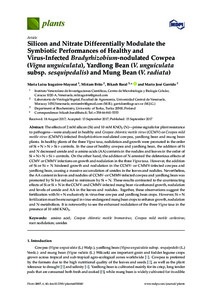Silicon and nitrate differentially modulate the symbiotic performances of healthy and virus-infected Bradyrhizobium-nodulated cowpea (Vigna unguiculata), Yardlong Bean (V. unguiculata subsp. sesquipedalis) and Mung Bean (V. radiata)
Mario José Garrido; Miriam Brito; Bikash Baral; Maria Luisa Izaguirre-Mayoral
https://urn.fi/URN:NBN:fi-fe2021042717557
Tiivistelmä
The effects of 2 mM silicon (Si) and 10 mM KNO3 (N)—prime signals for plant resistance
to pathogens—were analyzed in healthy and Cowpea chlorotic mottle virus (CCMV) or Cowpea mild
mottle virus (CMMV)-infected Bradyrhizobium-nodulated cowpea, yardlong bean and mung bean
plants. In healthy plants of the three Vigna taxa, nodulation and growth were promoted in the order
of Si + N > N > Si > controls. In the case of healthy cowpea and yardlong bean, the addition of Si
and N decreased ureide and -amino acids (AA) contents in the nodules and leaves in the order of
Si + N> N > Si > controls. On the other hand, the addition of N arrested the deleterious effects of
CCMV or CMMV infections on growth and nodulation in the three Vigna taxa. However, the addition
of Si or Si + N hindered growth and nodulation in the CCMV- or CMMV-infected cowpea and
yardlong bean, causing a massive accumulation of ureides in the leaves and nodules. Nevertheless,
the AA content in leaves and nodules of CCMV- or CMMV-infected cowpea and yardlong bean was
promoted by Si but reduced to minimum by Si + N. These results contrasted to the counteracting
effects of Si or Si + N in the CCMV- and CMMV-infected mung bean via enhanced growth, nodulation
and levels of ureide and AA in the leaves and nodules. Together, these observations suggest the
fertilization with Si + N exclusively in virus-free cowpea and yardlong bean crops. However, Si + N
fertilization must be encouraged in virus-endangered mung bean crops to enhance growth, nodulation
and N-metabolism. It is noteworthy to see the enhanced nodulation of the three Vigna taxa in the
presence of 10 mM KNO3.
Kokoelmat
- Rinnakkaistallenteet [19207]
